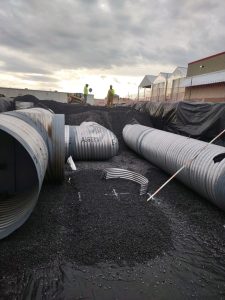By: Lane Enterprises, Inc
Storm water management shown on the preliminary construction plans addressed drainage from two separate areas that required water quality treatment before being directed into a common retention system.

Water quality was initially being addressed for each drainage area by using a hydrodynamic pre-treatment device that discharged into a StormTech Isolator Row before being directed into a common StormTech chamber infiltration (i.e. retention) system. The scheme allowed for a total phosphorous removal of 50% per the VA DEQ credit system established for these devices.
The City of Harrisonburg does not accept alternates once the construction plans are approved so it was critical to visit the engineer to discuss a more efficient storm water management plan that involved corrugated steel pipe (CSP) sand filters and a CSP retention system.
During discussions it was learned that the site drains into “Blacks Run,” a desig nated impaired stream per the Virginia Water Quality Assessment Integrated Report, meaning that the owner cannot purchase nutrient credits to mitigate water quality treatment requirements and must perform all required water quality treatment on site.

The most efficient treatment option approved by the VA DEQ for phosphorous reduction is in fact a sand filter. Traditionally, sand filters were constructed using long and very costly concrete vaults, but the design methodology can be more economically applied to large diameter CSP structures. The engineer and the owner decided to move forward utilizing two 84-inch diameter CSP sand filters with additional storage for the 10-yr storm provided by a 60-inch diameter perforated CSP storage system.
The sand filters replaced the two hydrodynamic separators and the two Isolator Rows. The CSP alternate also afforded additional treatment credits for the development which allowed for a much smaller conservation easement, freeing up additional area for development.